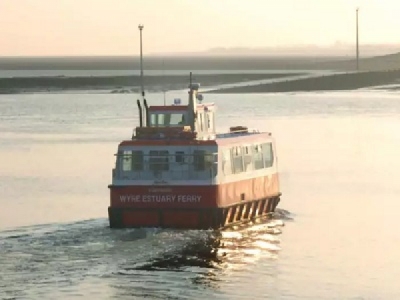
Posted on May 31, 2018
By Anthony Coppin, The Gazette
As the recently re-launched ferry service continues its journeys between Fleetwood and Knott End there are hopes it will be plain sailing for the good ship Wyre Rose and her friendly crew.
Despite the delay of the re-launch, caused by the unexpected withdrawal of the initial successful tenderer, Wyre Council and Lancashire County Council have now delivered the deal promised last year after the previous county administration pulled the plug on its 50 per cent subsidy of the service.
Brownie points for the current rulers of County Hall in what became a highly political issue in last May’s county elections. That poll was won locally by ‘Save our Ferry’ supporter Vivien Taylor.
Those with clear memories of the ferry’s history over the past few decades know problems and difficulties arise when least expected. Are there any storms brewing on the horizon which might affect the ferry? Those who use the Wyre Rose hope not. But various queries come to mind…
What happens in 2022 when the joint Wyre and county subsidies could come to an end? The new contract is clear about an eight-year period – ending in 2026 – though there is stress on the provision of “a self-sufficient service with initial financial support for four years” and “a break clause at year four”.
From that year onwards it could become a case of ‘who pays the ferryman?’
Another potential snag is a battle with the ever-rising deposits of silt in the estuary. The battle against silt has been on-going since the port of Fleetwood’s early days, with dredging playing a vital role in keeping the Wyre channel clear for shipping. The mud is still rising.
Accumulating deposits of silt on the riverbed means the ferry can no longer operate the long hours it did decades ago. The ferry’s sailing times are limited by the height of the tide on which the ferry floats and the mud deposits beneath the waves. In Fleetwood’s heyday there were four dredgers working permanently, keeping the Wyre channel clear for the vessels of the big commercial shipping companies then based in the port.
These days, with less frequent dredging, concerns about silt levels continue. One of the most visible example of changes in the riverbed is the much-publicised new ‘island’ in the Wyre estuary.
A special dredging session was held prior to the Wyre Rose starting her crossings again last month – and dredging aimed at keeping clear the ferry’s route between Fleetwood and Knott End will continue. Such future dredging will be the responsibility of ferry operator Wyre Marine Services which, in addition to the company’s role running the Wyre Rose, has a wealth of experience in dredging in UK waters.
According to Wyre Council: “The operator has made an allowance within their bid for ongoing maintenance dredging as required to sustain the service.
”Regular silt clearance around the slipway will also continue at a cost of up £3,000 a year. Passengers getting on and off the ferry at Knott End don’t – and won’t – have to walk through mud!
Will the costs earmarked to keep the channel open via dredging and silt clearance be enough to keep on top of clearing the relentless rise in the levels of mud and silt on the riverbed?
Ferry passengers certainly hope so.
While the county and Wyre are the major players in ferry matters, will there be a role for Preesall Town Council – and will cash from the town’s precept be directed towards the ferry service’s costs? Earlier this year – and shortly before the initially successful tenderer withdrew from the ferry deal – Preesall Council gave £5,000 from its reserves “towards the dredging work that needs to be undertaken before the start of the ferry contract.”
That move was proposed by Coun Phil Orme, who sits on both Preesall and Wyre Councils, but his request that the Preesall Council add a further £10,000 to its reserves “to cover any council contribution to the ferry over the full eight-year contract” was rejected.
Some Knott End and Preesall residents have made it clear, via Facebook posts, that while they welcome the return of the ferry, the subsidy bills should come from Wyre and the county, not the parish precept. Coun Orme, will be a key player in the ferry over the next few years, as Preesall Council’s representative on the ferry management board/working party, which will oversee the running of the ferry for the next eight years. The board/working party brings together the county, Wyre and contractors Wyre Marine Services.
With both Wyre and the county council now run by the same political party, the ruling groups of both have been keen to point out the savings to the public purse via the reduced subsidies.
County Coun Shaun Turner, who also sits on Wyre Council, has followed the various tussles over the ferry’s future over the past few years. He said the new contract meant savings for the council tax payer compared with the subsidy costs of the earlier contract. The subsidy for the ferry for 2016/17 was £76,550 from each authority (Wyre and LCC) per annum. The new subsidy works out at £42,102 from each authority a year for the next four years.
Coun Turner said: “This is a good deal for both Wyre, LCC and for the public who use the ferry. “Both authorities have worked closely to not only retain the ferry, but have done this with a far lesser cost to the public purse. An example, one might say, that efficiency savings can be found without cutting a service.”
Long gone are the days when more than 1m passengers a year used the ferry. These days the figure average around 60,000 a year – and clearly the supporting councils and the ferry operator believe it is worthwhile maintaining the historic river crossing.
Source: The Gazette





